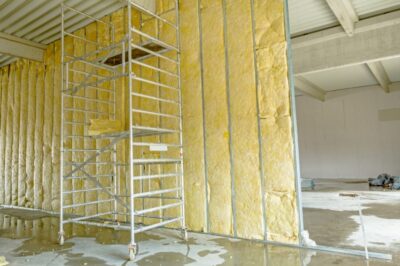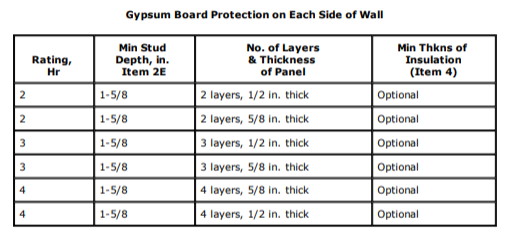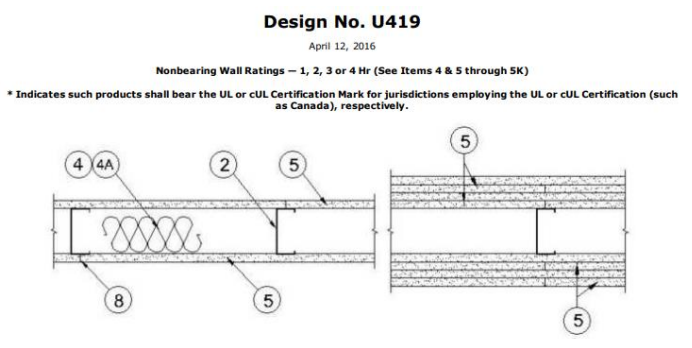A demising wall is a partition that separates one tenant space from another. Why is a demising wall important? Because it usually separates adjacent properties or real estate entities from each other and establishes limits between one property and another.
Many Names for a Demising Wall
There are many different names for a demising wall. Some call them separation walls, fire walls, party walls, divider walls, common walls, or occupancy separation walls.
They can be structural or non-structural walls located in almost any building type. In the United States, a party wall is the same as a demising wall.
Residential structures such as apartments, townhomes, and condos could all have demising walls.
Commercial buildings such as shopping centers, schools, hospitals, industrial warehouses, and office buildings could also include demising walls.
Demising Wall Definition
The definition of a demising wall is a partition or wall specifically used to separate two different occupancies, common areas, or tenant’s space.
Demising walls are typically used in buildings with multiple tenants like office buildings, apartment building, retail strip malls, or commercial buildings. The walls extend from the concrete floor to the underside of the tenant structure or roof deck.
They also run horizontally to exterior walls, or CMU, concrete structural walls, or other rated partitions.
Fire-rated walls must be continuous to the exterior of the building or other rated assemblies inside the building.

The Purpose of a Demising Wall
Typically, a demising wall is used for creating a separation between tenant spaces, but the use of a demising wall doesn’t stop there. There are many purposes for a demising wall beyond simply dividing areas.
Another primary purpose of the wall is fire safety, and a demising wall creates separation in the event of a fire.
This is why a demising wall is also referred to as a firewall. In construction and real estate, safety is always the first priority.
Fire Protection
One of the most important aspects of building safety is fire protection and containing or preventing the spread of a fire if it occurs. This is where the demising wall plays a major role.
Usually, demising walls create a sound barrier and are insulated to reduce sound transmission and noise levels through two tenant spaces.
Sometimes, resilient channels will be added to the demising wall to reduce the transmission of vibration and extra sound barrier protection.
Insulation will also help with energy efficiency between two tenant spaces. One large space might remain unfinished, so the insulation will hold the heat or cool air in the finished space.

The Fire-Rated Demising Wall
In the event of a fire, demising walls prevent the spread of the fire from one private space to the next. If your neighbor starts a fire in their kitchen, a demising wall prevents the spread of that fire into your unit.
In these situations, proper construction of a demising wall needs to follow strict guidelines and be built to certain specifications to assure a “fire rating” is achieved.
Architects specify the exact assembly and material for use in constructing demising walls.
As they are built, typically, inspections are held to assure the architect’s specifications have been carried out during construction.
One-Hour Rated Demising Wall Assemblies
There are many different one-hour-rated assemblies for demising walls. It’s the architect’s job to specify the type of wall and the material to be used for the construction of the wall.
The blueprints are usually submitted to a city or local building jurisdiction to approve or deny the design the architect has proposed.
Once approved, the construction process is inspected to assure the approved plans and specifications have been followed, and the building meets applicable laws.

Demising Wall Assembly
One example of a typical 1 Hour fire-rated interior wall, which could also be a demising wall, is shown in the detail above.
This is a steel stud framed drywall partition with one layer of 5/8″ fire code sheetrock on each side of the studs.
You might notice the description on the right column noting “UL Des U419.” This is a wall assembly approved by United Laboratories (U.L.), which has undergone extensive certification and testing to ensure the wall actually prevents fire spread for a minimum of one hour.

There are dozens of special construction assemblies, such as the one-hour-rated assemblies, including many different material combinations.
Each assembly includes slightly different materials to accommodate the different conditions and building types where demising walls are used.
All these one-hour-rated assemblies do have one thing in common, and that is the UL-rated designation, which means they have been rigorously tested and approved by United Laboratories for the specific fire rating.
Two-Hour Rated Demising Wall Assemblies
Two-hour rated demising wall assemblies are designed with the same concepts as the one-hour demising wall.
The main difference is their construction will assure a fire-resistance rating to withstand a standard fire-resistance test for two hours instead of one.

In the two-hour rated wall assembly above, a steel stud wall is used to frame the firewall, then two layers of 5/8″ fire-code gypsum drywall are applied to each side.
The U.L. designation appears in the right column noted as “UL Des U419.” Commonly referred to as a “UL 419.”
You might have noticed the U419 designation applies to both one-hour and two-hour walls above. A three-hour and four-hour assembly also exists for the U419 designation.

Requirements
Fire-rated demising walls require a ‘head-of-wall’ system to isolate and confine a fire and stop the spread of flames and heat to adjoining spaces.
The space between the rated separation wall and the bottom of the building structure must be treated with fire-resistant materials.
Why is the head-of-wall space so important? One of the factors that make fire containment difficult is that buildings have movement. When a building moves, there’s a potential gap in the rated demising wall.
Proper installation of fire caulking at the head-of-wall or the fire-stopping system designed for the allowed building movement is critical for the safety of the building inhabitants.
Many Types of Demising Walls
There are so many different types of demising walls; it’s almost tough to count them all.
Many are constructed out of concrete, CMU block, wood framing and drywall, and many different combinations.
Again, it’s the architect and building designer’s job to specify wall types that satisfy the local building codes and ensure they are appropriate for the building structures they are designing.
And it’s the construction contractor’s job to ensure the walls (and the rest of the building) are built precisely to the standards laid out in the plans and specs.
It’s also the local building inspectors’ job to verify and confirm all instructions were carried out to the fullest extent.
Demising Wall Vs. Separation Wall
Some walls might appear to be demising walls, but they are only separation walls.
A warehouse space might have tall warehouse divider walls, but if they are not fire-rated, technically, they would not be considered demising walls.
Industrial tall walls might divide work areas and look like demising walls, but if they don’t include specific UL numbers and do not separate adjacent tenants, they would not be demising walls.
The Importance of Demising Walls
Maybe you are new to the term “demising walls,” but I can guarantee this partition wall has played a major role in the safety of thousands of people over the years in the United States.
For any building that has multiple occupancies and uses, the potential for fires is endless.
One of the primary objectives of the demising wall is to not only delay the spread of the fire throughout the building but to protect the building’s structural members from preventing a total collapse.
Allowing Time for Safe Exit
Giving occupants enough time to exit the building safely is the job of the demising wall.
Apartment complexes could have hundreds or even thousands of separate units, all protected by demising walls.
It’s not only demising walls that protect occupants from a fire in a building. Sprinkler systems, fire alarms, and numerous other systems all play a part in fire safety to protect people in the event of building fires.
But when designed and constructed correctly, separation walls play a vital role in public safety.
Modular Wall Systems
You might be thinking demising walls must be built on-site, and cannot be panelized in modular wall panel systems.
But modular demising walls might be the perfect solution for your next tenant improvement project.
Several modular wall companies offer interior solutions for demising wall systems, built inside their own manufacturing plants on production lines and ready to be delivered.
This includes wood-framed demising partitions and steel frame studs.
As long as the partition components comply with building codes and meet the required specifications, separation walls can be built off-site, delivered, and installed as modular wall panels.
Estimating Demising Walls
Drywall estimators are constantly identifying demising walls on plans and confirming the interior wall assembly location and details.
Here are a few good questions to ask when bidding on a tenant improvement or commercial alterations.
- Where are the tenant spaces, and where is the demising wall for each space?
- Does the existing building have a separation wall currently, or will they require new demising walls?
- What’s the deck height of the building?
- Will the dividing wall require new drywall on one side of the wall or the other?
- Does the existing demising wall have a level 4 finish or only fire tape?
- If the space has an existing demising wall with drywall, will the wall require patching of the existing gypsum board and repair work, so it’s ready for paint?
- For a new demising wall, identify the UL number. And confirm if the wall is a one-hour wall, two, three, or four-hour rated wall.
- Will the new separation wall be framed with 3 5/8″ steel studs, 6″ studs, or 8″ studs?
- Does the new wall require insulation?
Did You Know?
The word ‘demising‘ is from the Latin word ‘dimittere,’ meaning to let go, disband, or discharge after service in the military.
But in the modern english language, ‘demising‘ means termination, decease, or death, such as the demise of an empire.
READ more about other popular drywall products –
Best Sandpaper For Drywall, Tips And Tricks
Green Board: The Basics Of Water-Resistant Drywall
Additional Resources –
UL Wall Assemblies – USG Handbook
Fire Resistance Systems and Designs – United Laboratories (UL)
Fire Standards and Flammability Standards – ASTM International



